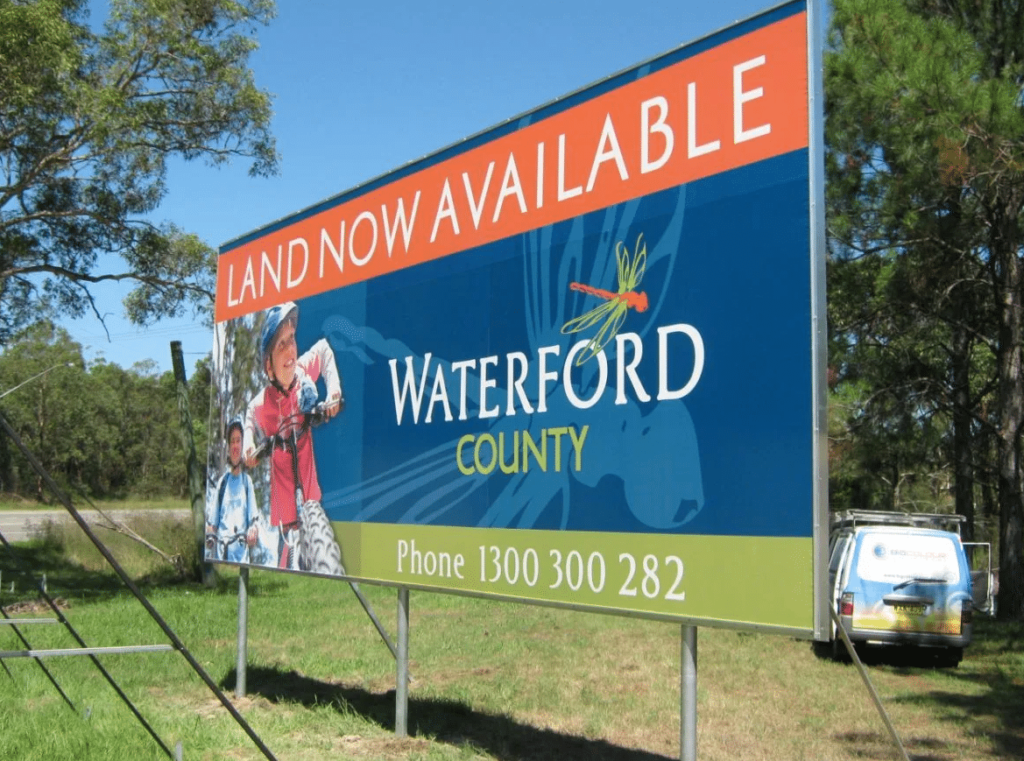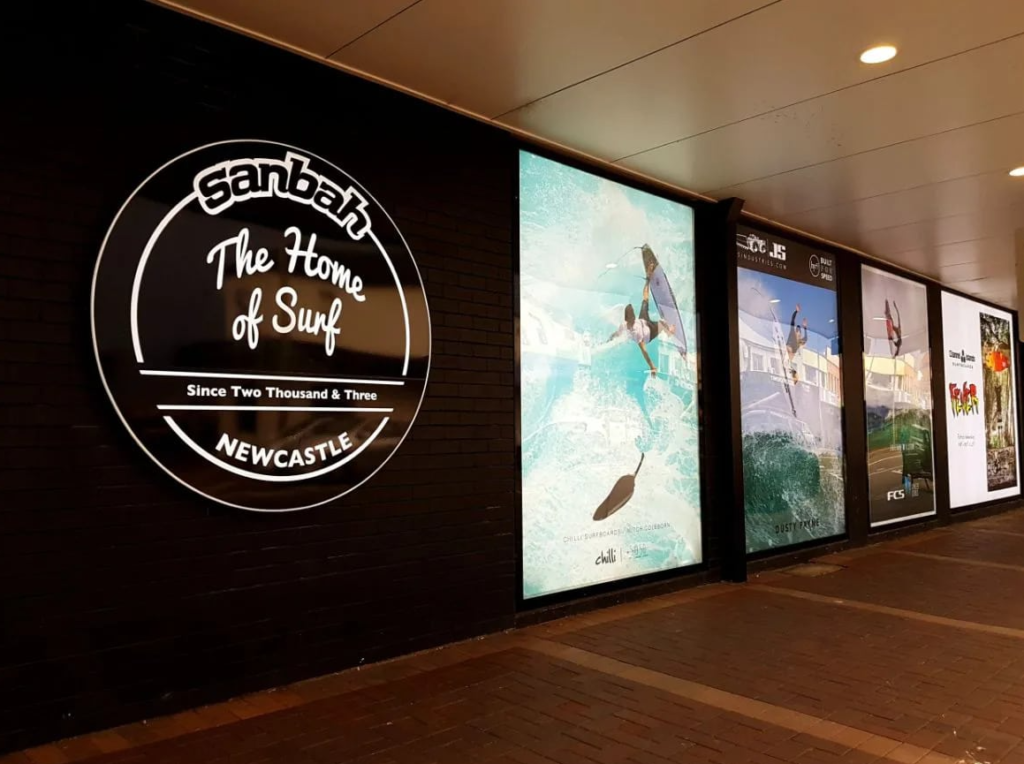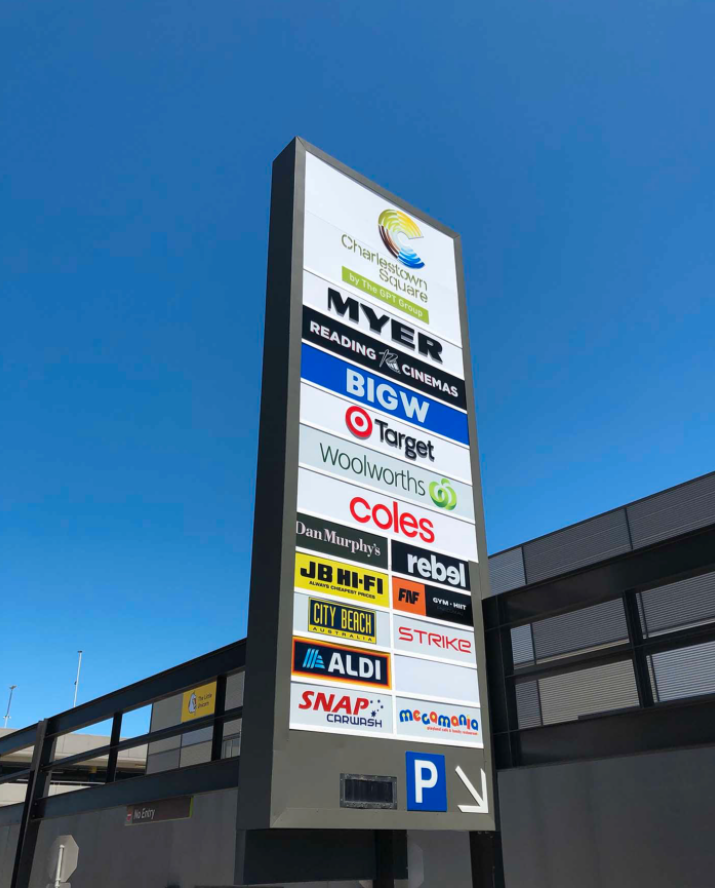The signage construction in bulk or flat design is located, as a rule, on the facade of the building, next to the entrance, which informs about the organization or company, located inside the building.
Modern signage usually performs two functions that are difficult to separate from one another: it is information delivery and as a means of advertising, the signage belongs to the category of outdoor advertising and, above all, performs an image function.
According to the fact, the signage is the business card of a building or premises, to help the visitor to understand, that is inside, not stepping inside.
Signs can be conventionally divided into light and non- light .
Non-illuminated signs

For non-illuminated signboards are signed, not having their own illumination. Usually, such a signage is an image or an inscription on a substrate ( most often made of metal, cellular polycarbonate or foamed PVC ). The image may be printed on vinilivoy film and glued on the substrate ,or applied by a direct UV – printing . Plates are also referred to non- illuminated signs .
Non-illuminated advertising signs – it is the least expensive segment in the means of outdoor advertising. They allow multiple reduced spending on advertising design, by comparison with the light constructs. K disadvantages nonoptical signage should include their inefficiency by comparison with light signage in the evening and night time.
Illuminated signs

Light box ( lightbox )
The most popular type of sign . It is an a frame , most likely rectangular ( but , does not always ) the design , the front part of which is an advertising vehicle . From within the light box is illuminated in dark time of day , most of all , by means of fluorescent lamps .
Budget light boxes are made of galvanized steel , the front part is made of cellular polycarbonate with a rolled film with an image . In a backlight using the fluorescent lamp .
Light box middle class made from aluminum profile ( housing ), in a front part of the surface using acrylic glass ( plexiglass ) with knurled film with the image . In a backlight using the fluorescent lamp .
The most expensive lightboxes have a rigid welded frame of aluminum tubes, the front and side of the box are executed from a composite material with the milling. Image – acrylic glass with applique, or full-color printing, planted inside. Backlight – LEDs, or neon.
Light volumetric letters
More costly, but also more effective in comparison with lightboxes, sign. It represents curly volumetric letters with various types of backlighting.
The most common types of volumetric letters are:
- Closed volumetric letters are made of plexiglass, sides – aluminum profile ( ALS ) or foamed plastic ( polyvinyl chloride ), internal lighting – neon or LEDs. Side and front surfaces are often covered with special vinyl films.
- Volumetric letters with ” open neon “. Bright ads in the style of ” Night Las – Vegas “. Most of the all-metal letters without the front panel, the neon tube disposed inside the housing letters, there is also a variant, when the neon lamp arranged on the front surface of the letters. TO Disadvantages can include unsteadiness to vandalism.
- Volumetric letters with kontrazhurnoy ( reverse ) illumination. In this case, the source of light ( neon lamps or LEDs ) are arranged in letters illuminating the facade and creating spectacular illumination ( dark letters, surrounded by a shining halo ).
Less common types of bulk letters:
- Volumetric letters with combined illumination. In this case, the source of light inside is such a way, to illuminate simultaneously and the front portion and rear (kontrazhur), creating the effect of light letters hovering in the air.
- Volumetric ( or more often pseudo-volumetric ) letters with open LED backlighting. Open sealed LED pixels, modules ( clusters ), or strips are installed on the front of the letters completely or along the contour. They are distinguished by high brightness.
- 3D letters in aluminum or stainless steel. Casings letters soldered or welded from metal. Independence of the type of selected illumination in the front or rear portion of the letter set light scattering, or transparent plexiglass, polystyrene, or other special material. Such signs are usually They are expensive and must be ordered, usually, banks and expensive boutiques.
Neon signs
They compete with lamp versions, are unpretentious to weather and temperature extremes, and do not irritate the eyes. The most popular neon filling tubes are flexible materials. Variety of neon colors, pleasant warm glow, and high energy efficiency are decisive factors when it comes to illuminating a sign.
LED signs
Their advantage is the ability to change color or smooth transition (flickering effect, running lights, backlighting, etc.). In the long run, they turn out to be cheaper, rarely break, unlike neon ones.
Advertising sign prices

The price is for 1 sq. m or 1 cm in height (for letters). Installation cost not included: lightboxes: from 4500 dollars; frame lights: from 4500 dollars; acrylates: from 4000 dollars; crystal lights: from 5000 dollars; light letters: from 80 dollars; street light panels: from 3000 dollars; panel-brackets: from 7000 dollars; metal and plastic letters: from 90 dollars; letters with neon: from 130 dollars; neon constructions: from 30 dollars: non-illuminated signs: from 1900 dollars; office plates: from 1100 dollars; firewalls (panels): from 250 dollars; roof installations: from 15,000 dollars.
Requirements for advertising signs
- Content: information field with text plus artistic elements.
- Placement on facades and sites without plaques, address plates, or architectural compositions; there must be only one roof unit (at one site).
- Information plates height – 50 cm, width – 70% of the facade (no more than 15 m); the height of the letters – up to 10 cm, the size of the inscription – not less than 15 cm (Resolution 902 + recommendations and legal regulations of the city authorities).
- Language (in the absence of registration of a trademark in another language).
- At night, the sign should be illuminated.
- Should contain text or graphic information (thematic icons or figures); additionally – Art. 5, 19 No. 38-FZ.
- All signs should be aligned and consistent with the overall architectural style.
Servicing advertising signs
His responsibilities include
- condition diagnostics (fasteners, electrics);
- repairs;
- preventive work;
- cleaning the structure;
- replacement of worn parts. When ordering an advertising sign, you can conclude a repair and maintenance contract with a quarterly service.
Washing of advertising signs
The exterior of the sign is washed as it gets dirty. The cleaning of the interior according to the plan is carried out 1 time in 3 months. Special cleaning agents or equipment are used that do not damage microcircuits and electrical networks. Washing of signboards with household chemicals is not allowed, since the structure may fade or become unusable.
Dismantling an advertising sign
Dismantling is carried out through a contractor using special equipment and climbing equipment (at height). In case of receiving an order to dismantle the sign, the procedure is carried out within 30 days. Otherwise, the dismantling will be carried out by state services, for which an additional fine is imposed.
Advertising Permission
Signboards by the decision of different courts can be recognized as informational and advertising, and unauthorized installation of advertising is punishable by law. Therefore, permission to install a sign is obtained regardless of the guarantees of advertising agencies. To do this, contact the town planning department, and upon receipt of a positive answer, the project is coordinated with the administration.
Additionally, they receive permission if the building is not in personal ownership (lease agreement). To do this, organize an
- auction (state municipal property);
- residents voting (apartment buildings). The permit is obtained for 5 years. If the plate is recognized as informational, then permission will not be required.